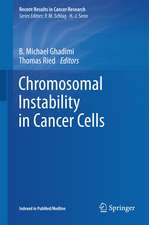Insertional Mutagenesis Strategies in Cancer Genetics
Editat de Adam J. Dupuy, David A. Largaespadaen Limba Engleză Paperback – 7 oct 2014
| Toate formatele și edițiile | Preț | Express |
|---|---|---|
| Paperback (1) | 710.96 lei 6-8 săpt. | |
| Springer – 7 oct 2014 | 710.96 lei 6-8 săpt. | |
| Hardback (1) | 716.28 lei 6-8 săpt. | |
| Springer – 19 noi 2010 | 716.28 lei 6-8 săpt. |
Preț: 710.96 lei
Preț vechi: 748.38 lei
-5% Nou
Puncte Express: 1066
Preț estimativ în valută:
136.04€ • 142.05$ • 112.34£
136.04€ • 142.05$ • 112.34£
Carte tipărită la comandă
Livrare economică 15-29 aprilie
Preluare comenzi: 021 569.72.76
Specificații
ISBN-13: 9781489981349
ISBN-10: 1489981349
Pagini: 208
Ilustrații: VIII, 200 p.
Dimensiuni: 155 x 235 x 11 mm
Greutate: 0.3 kg
Ediția:2011
Editura: Springer
Colecția Springer
Locul publicării:New York, NY, United States
ISBN-10: 1489981349
Pagini: 208
Ilustrații: VIII, 200 p.
Dimensiuni: 155 x 235 x 11 mm
Greutate: 0.3 kg
Ediția:2011
Editura: Springer
Colecția Springer
Locul publicării:New York, NY, United States
Public țintă
ResearchCuprins
Chapter 1: Introduction: Author: Anton Berns (Netherlands Cancer Institute).- Chapter 2: Retroviral mutagenesis in mouse leukemia/lymphoma: Author: David Largaespada, Ph.D. (University of Minnesota).- Chapter 3: MMTV models of breast cancer: Author: John Hilkens (NKI).- Chapter 4: Retroviral mutagenesis in other organisms: Author: Michael Dvorak (Inst. Of Molecular Genetics, Prague, Czech Rep.).- Chapter 5: Sleeping Beauty models of cancer: Author: Adam J. Dupuy, Ph.D. (University of Iowa).- Chapter 6: Insertional mutagenesis in gene therapy patients: Author: David Williams, M.D. (Cincinnati Children’s Hospital).- Chapter 7: Bioinformatics of high throughput insertional mutagenesis: Author: Keiko Akagi (NCI-Frederick).
Notă biografică
Adam Dupuy, Ph.D., is an Assistant Professor at the Carver College of Medicine at the University of Iowa, and a rising star in the field of insertional mutagenesis; two of the last of his publications have been in Nature, and he was the lead author on one of these. Dr. Dupuy earned his B.A. at Central College in Pella, Iowar, went on to earn his Ph.D. at the University of Minnesota in the Program in Molecular, Cellular, Developmental Biology & Genetics, and did his Postdoctoral fellowship in the Mouse Cancer Genetics Program at the NCI-Frederick.
Textul de pe ultima copertă
Over the past decades, insertional mutagenesis has played an important contribution to our understanding of cancer. Initially, the action of slow transforming retroviruses was used to identify endogenous cellular oncogenes (e.g. Myc, Myb). These observations sparked a series of experiments that eventually led to the idea cancer is caused by somatically acquired mutations in endogenous oncogenes and tumor suppressor genes.Since these discoveries, insertional mutagenesis has been used to identify novel cancer genes in a variety of tumor types in animal models of cancer. More recent work has developed novel insertional mutagens, such as transposons, that have broader capabilities to model cancer in vivo. While this work has focused on developing animal models of cancer, recent gene therapy trials in human patients have shown that insertional mutagenesis can also contribute to transformation.The goal of this work is summarize the contribution that insertional mutagenesis has made to our understanding of cancer. A variety of insertional mutagens are presented that have been used to study a variety of tumor types in several model organisms. In addition, the impact of insertional mutagenesis in several gene therapy trials is discussed along with strategies to avoid such complications in future clinical trials.
Caracteristici
This work summarizes the contribution that insertional mutagenesis has made to our understanding of cancer A variety of insertional mutagens are presented that have been used to study a variety of tumor types in several model organisms The impact of insertional mutagenesis in several gene therapy trials is discussed along with strategies to avoid such complications in future clinical trials Includes supplementary material: sn.pub/extras










